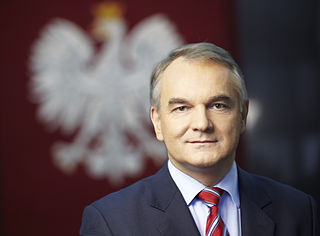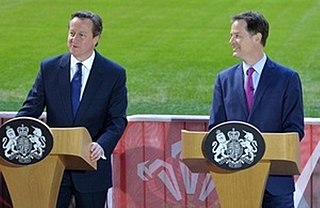
The president of the Council of Ministers, colloquially and commonly referred to as the prime minister, is the head of the cabinet and the head of government of Poland. The responsibilities and traditions of the office stem from the creation of the contemporary Polish state, and the office is defined in the Constitution of Poland. According to the Constitution, the president nominates and appoints the prime minister, who will then propose the composition of the Cabinet. Fourteen days following their appointment, the prime minister must submit a programme outlining the government's agenda to the Sejm, requiring a vote of confidence. Conflicts stemming from both interest and powers have arisen between the offices of President and Prime Minister in the past.
The Labour Party is a social-democratic political party in the Netherlands.

From 1989 through 1991, Poland engaged in a democratic transition which put an end to the Polish People's Republic and led to the foundation of a democratic government, known as the Third Polish Republic, following the First and Second Polish Republic. After ten years of democratic consolidation, Poland joined NATO in 1999 and the European Union on 1 May 2004.

Vishwanath Pratap Singh, shortened to V. P. Singh, was an Indian politician who was the 7th Prime Minister of India from 1989 to 1990 and the 41st Raja Bahadur of Manda. He is India's only prime minister to have been former royalty.

Jan Ferdynand Olszewski was a Polish conservative lawyer and politician who served as the Prime Minister of Poland for five months between December 1991 and early June 1992 and later became a leading figure of the conservative Movement for the Reconstruction of Poland.

Hanna Stanisława Suchocka is a Polish political figure, lawyer, professor at Adam Mickiewicz University in Poznań and Chair of the Constitutional Law Department, former First Vice-President and Honorary President of the Venice Commission.

Janusz Adam Onyszkiewicz is a Polish mathematician, alpinist, politician who served as Minister of Defence twice, in the cabinets of Hanna Suchocka (1992–1993) and Jerzy Buzek (1997–2000).

Jan Krzysztof Bielecki is a Polish liberal politician and economist. A leading figure of the Gdańsk-based Liberal Democratic Congress in the early 1990s, Bielecki served as Prime Minister of Poland for most of 1991. In his post-political career, Bielecki served as president of Bank Pekao between 2003 and 2010, and served as the president of the Polish Institute of International Affairs between 2009 and 2015. Since the early 2000s, Bielecki has been a member of the Civic Platform party. In 2010, the Warsaw Business Journal described Bielecki as one of the most respected economists in Poland.

The 1911 New Zealand general election was held on Thursday, 7 and 14 December in the general electorates, and on Tuesday, 19 December in the Māori electorates to elect a total of 80 MPs to the 18th session of the New Zealand Parliament. A total number of 590,042 (83.5%) voters turned out to vote. In two seats there was only one candidate.
There is no official document specifying the order of precedence in Poland. In practice, the precedence of officials in Poland is based on an outdated informal instruction dating back to 1992. Polish civil servants responsible for the protocol often need to make ad hoc decisions based on tradition, general rules of etiquette and common sense.

Ewa Bożena Kopacz is a Polish politician who has served as a Vice-President of the European Parliament since 2019. She previously was Marshal of the Sejm from 2011 to 2014, the first woman to hold the office, as well as Prime Minister of Poland from 2014 to 2015. In addition, Kopacz was Minister of Health from 2007 until 2011. Since 2001, she has been a member of Civic Platform, which she chaired from 2014 to 2016. Kopacz succeeded Donald Tusk as prime minister, becoming the second woman to hold the office after Hanna Suchocka (1992–1993). Her term as prime minister ended on 16 November 2015, when she was succeeded by Beata Szydło.

The Council of Women World Leaders, created in 1996, is a network of 83 current and former presidents and prime ministers. It is the only organization in the world dedicated to women heads of state and government. The council's Ministerial Initiative also involves current and former cabinet ministers and secretaries in the work of the council.
UOP Instruction nr 0015/92 was an internal instruction of Urząd Ochrony Państwa issued in October 1992, which allowed the illegal surveillance and, allegedly, the fomenting of the dissolution of those Polish political parties that were in opposition to the Cabinet of the then Prime Minister Hanna Suchocka or to President Lech Wałęsa.

Second Cabinet of Waldemar Pawlak was the government of Poland from 18 October 1993 – 6 March 1995 during the 2nd legislature of the Sejm and the 3rd legislature of the Senate. It was appointed by President Lech Wałęsa on 18 October 1993, and passed the vote of confidence in Sejm on 10 November 1993. Led by Waldemar Pawlak, it is a centre-left coalition of two major parties: social democratic Democratic Left Alliance (SLD) and the agrarian Polish People's Party (PSL). Waldemar Pawlak succeeded Hanna Suchocka, who was the first female Polish Prime Minister.
Waldemar Pawlak is the only person to serve twice as Prime Minister of the Republic of Poland during the Third Republic period (1989–present).

The Cameron–Clegg coalition was formed by David Cameron and Nick Clegg when Cameron was invited by Queen Elizabeth II to form a government, following the resignation of Prime Minister Gordon Brown on 11 May 2010, after the general election on 6 May. It was the UK's first coalition government since the Churchill caretaker ministry in 1945.
The Polish People's Party – Peasants' Agreement, commonly known simply as Peasants' Agreement (PL), was an agrarian and Christian-democratic political party in Poland.
Events during the year 1992 in Poland.












